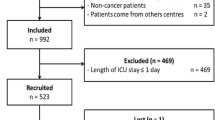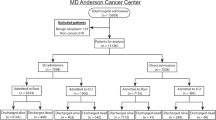Abstract
Aim
The aim of this study was to identify the incidence, causes, risk factors and interventions for cancer patients requiring unplanned admissions within 14 days of discharge at a large metropolitan private hospital without a co-located emergency department.
Methods
Retrospective data were collected on cancer patients who had an unplanned admission within 14 days of discharge during the period December 1, 2011 and May 31, 2012. Data were collected from the inpatient bed administration database and medical record review. Variables collected included demographics, cancer diagnosis, reasons for admission, interventions, and length of stay.
Results
A total of 133 oncology patients required 206 unplanned admissions (UPAs). The most common cancer diagnoses associated with unplanned readmission were upper gastrointestinal (25.4 %), colorectal (19.6 %), gynaecological (18.8 %) and breast (13.8 %) cancers. The symptoms most commonly associated with unplanned re-admission were pain (16 %); infection not associated with neutropaenia (15.5 %); fever and febrile neutropaenia (14.6 %); nausea, vomiting and dehydration (13.6 %); dyspnoea (8.3 %) and altered neurological status (7.8 %). The median length of stay (LOS) was 6 days. Length of stay during UPA was decreased for patients with a partner and for those who had a palliative care consult. The need for psychological supports was related to a longer LOS during UPA.
Conclusion
Cancer patients are at a significant risk of requiring unscheduled care and admission. Strategies and services to limit the burden on patients and the health care system should be reviewed to minimise the incidence of unplanned admission.
Similar content being viewed by others
References
McKenzie H, Hayes L, White K, Cox K, Fethney J, Boughton M, Dunn J (2010) Chemotherapy outpatients’ unplanned presentations to hospital: a retrospective study. Support Care Cancer 19:963–969
Hassett MJ, O’Malley AJ, Pakes JR, Newhouse JP, Earle CC (2006) Frequency and cost of chemotherapy-related serious adverse effects in a population sample of women with breast cancer. J Natl Cancer Inst 98(16):1108–1117
Livingston PM, Craike M, Considine J (2011) Unplanned presentation to emergency departments due to chemotherapy induced complications: opportunities for improving service delivery. Aust Emerg Nurs J 14:62–68
Mitchell T (2007) The social and emotional toll of chemotherapy—patients’ perspectives. Eur J Cancer Care 16:39–47
American Hospital Association (2011) Examining the drivers of readmissions and reducing readmissions for better patient care. TrendWatch, Washington. http://www.aha.org/research/reports/tw/11sep-tw-readmissions.pdf
Henretta MS, Scalici JM, Engelhard CL, Duska LR (2011) The revolving door: hospital readmissions of gynaecologic oncology patients. Gynecol Oncol 122:479–483
Williams VM (2008) The cancer reform strategy. Clin Oncol 20:271–274
Cohen L, de Moor CA, Eisenberg P, Ming EE, Hu H (2007) Chemotherapy-induced nausea and vomiting—incidence and impact on patient quality of life at community oncology settings. Support Care Cancer 15:497–503
Fromme EK, Eilers KM, Mori M, Hsieh Y-C, Beer TM (2004) How accurate is clinical reporting of chemotherapy adverse effects? A comparison with patient-reported symptoms from the quality-of-life questionnaire C30. J Clin Oncol 22(17):3485–3490
Considine J, Livingston P, Bucknall T, Botti M (2009) A review of the role of emergency nurses in management of chemotherapy-related complications. J Clin Nurs 18:2649–2655
Martin CG, Kennedy KF, Elting LS, Manzullo EM, Escalante CP, Rubenstein EB (1996) Incidence of emergency visits among oncology patients receiving outpatient chemotherapy: implications for care in a capitated market. Cancer Control 3(5):435–441
Tas F, Argon A, Disci R, Topuz E (2007) Pattern and outcome of admission to a medical oncology inpatient service. J Cancer Educ 22(2):80–85
Nirenberg A, Mulhearn L, Lin S, Larson E (2004) Emergency department waiting times for patients with febrile neutropaenia: a pilot study. Oncol Nurs Forum 31(4):711–715
Callen JL, Blundell L, Prgomet M (2008) Emergency department use in a rural Australian setting: are factors prompting attendance appropriate? Aust Health Rev 32(4):710–720
Diaz-Couselo FA, OÇonnor MJ, Nervo A, Tossen G, Guercovich A, Puparelli C, Zylberman M (2004) Nonscheduled consultation in oncologic patients. How many of these are true emergencies? An observational prospective study? Support Care Cancer 12:274–277
Craike MJ, Livingston PM, Considine M (2010) Emergency department presentations of patients from CALDB receiving chemotherapy in day oncology settings. Aust Emerg Nurs J 13:111–116
Bozdemir N, Eray A, Senol Y, Artac M, Samur M (2009) Demographics, clinical presentations and outcomes of cancer patients admitted to the emergency department. Turk J Med Sci 39(2):235–240
Majem M, Galan M, Perez FJ, Munoz M, Chicote S, Soler G, Germa JR (2007) The oncology acute toxicity unit (OATU): an outpatient facility for improving the management of chemotherapy toxicity. Clin Transl Oncol 9:784–788
National Hospitals Data Collection Centre (2010) Cost report round 13 2008–2009. Retrieved from. http://www.health.gov.au/internet/main/publishing.nsf/Content/health-casemix-data-collections/publications-NHCDC-AHPCS
Tsai S-C, Liu L-N, Tang S-T, Chen J-C, Chen M-L (2010) Cancer pain as the presenting problem in emergency departments: incidence and related factors. Support Care Cancer 18:57–65
Dennis K, Librach SL, Chow E (2011) Palliative care and oncology: integration leads to better care. Oncology (Williston Park) 25:1271–1275
Brunetto AT, Ang JE, Olmos D, Tan D, Bariuso J, Arkenau H-T, Kaye S (2010) A study of the pattern of hospital admissions in a specialist phase I oncology trials unit: unplanned admissions as an early indicator of patient attrition. Eur J Cancer 46:2739–2745
Weaver C, Schiech L, Held-Warmkessel J, Kadziera P, Haney E, DiLullo G, Barsevick A (2006) Risk of unplanned hospital readmission of patients with cancer: results of a retrospective medical record review. Oncol Nurs Forum 33(3):E44–E52
deBoer A, Wijker W, de Haes H (1997) Predictors of health care utilization in the chronically ill: a review of the literature. Health Policy 42(2):101–115
Puts MTE, Monette J, Girre V, Wolfson C, Monette M, Batist G, Bergman H (2010) Does frailty predict hospitalization, emergency department visits and visits to the general practitioner in older newly-diagnosed cancer patients? Results of a prospective pilot study. Crit Rev Oncol Hematol 76:142–151
Yates M, Barrett A (2009) Oncological emergency admissions to the Norfolk and Norwich university hospital: an audit of current arrangements and patient satisfaction. Clin Oncol 21:226–233
Du XL, Osborne C, Goodwin JS (2002) Population-based assessment of hospitalizations for toxicity from chemotherapy in older women with breast cancer. J Clin Oncol 20(24):4636–4642
Lai JK, Martin MA, Meyricke R, O’Neill T, Roberts S (2007) Factors associated with short-term hospital readmission rates for breast cancer patients in western Australia: an observational study. J Am Coll Surg 204(2):193–200
Molassiotis A, Brearly S, Saunders M, Craven O, Wardley A, Farrell C, Luker K (2008) Effectiveness of a home care nursing program in the symptom management of patients with colorectal and breast cancer receiving oral chemotherapy: a randomized control trial. J Clin Oncol 27(36):6191–6197
Graham D and McKerrow J (2006) Frequency of urgent/emergency symptoms assessed by triaging nurse for oncology patients seeking treatment at a comprehensive cancer centre. ONS Congress Abstract 2006
Miranda V, Fede A, Nobuo M, Ayres V, Giglio A, Miranda M, Riechalmann MD (2011) Adverse drug reactions and drug interactions as causes of hospital admission in oncology. J Pain Symptom Manag 42(3):342–353
Courtney MD, Aldeen AZ, Gorman SM, Handler JA, Trifilio SM, Parada JP, Bennett CL (2007) Cancer- associated neutropenic fever: clinical outcome and economic costs of emergency department care. Oncologist 12:1019–1026
Lim JH, Kim H, Choi WG, Kim KH, Shin DW, Lee MH (2011) Outcomes in 102 patients that presented to the emergency department with chemotherapy-induced febrile neutropaenia. Turk J Hematol 28:193–197
Klatersky J, Paesmans M, Georgala A, Muanza F, Plehiers B, Dubreucq L, Barette M (2006) Outpatient oral antibiotics for febrile neutropenic cancer patients using a score predictive for complications. J Clin Oncol 24(25):4129–4134
Innes H, Marshall E (2007) Outpatient therapy for febrile neutropaenia. Curr Opin Oncol 19:294–298
Demshar R, Vanek R, Mazanec P (2011) Oncologic emergencies new decade, new perspectives. AACN Adv Crit Care 22(4):337–348
Blinman PL, Grimison P, Barton MB, Crossing S, Walpole ET, Wong N, Koczwara B (2012) The shortage of medical oncologists: the Australian medical oncology workforce study. Med J Aust 196(1):58–61
Huws DW, Cashmore D, Newcombe RG, Roberts A, Vincent J, Elwyn G (2008) Impact of case management by advanced practice nurses in primary care on unplanned hospital admissions: a controlled intervention study. BMC Health Serv Res 8:115
Acknowledgments
The authors wish to thank Professor Duncan Boldy, Research Consultant, for his statistical advice.
Conflict of interest
The authors declare no conflict of interest. The corresponding author has full control of all primary data and agrees to allow the journal to review the data if requested.
Author information
Authors and Affiliations
Corresponding author
Rights and permissions
About this article
Cite this article
Gibson, S., McConigley, R. Unplanned oncology admissions within 14 days of non-surgical discharge: a retrospective study. Support Care Cancer 24, 311–317 (2016). https://doi.org/10.1007/s00520-015-2786-6
Received:
Accepted:
Published:
Issue Date:
DOI: https://doi.org/10.1007/s00520-015-2786-6




